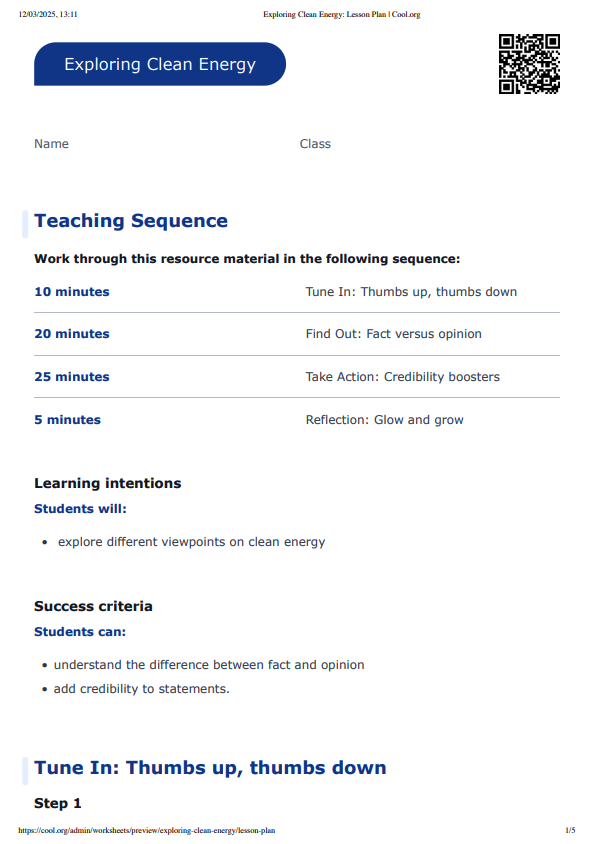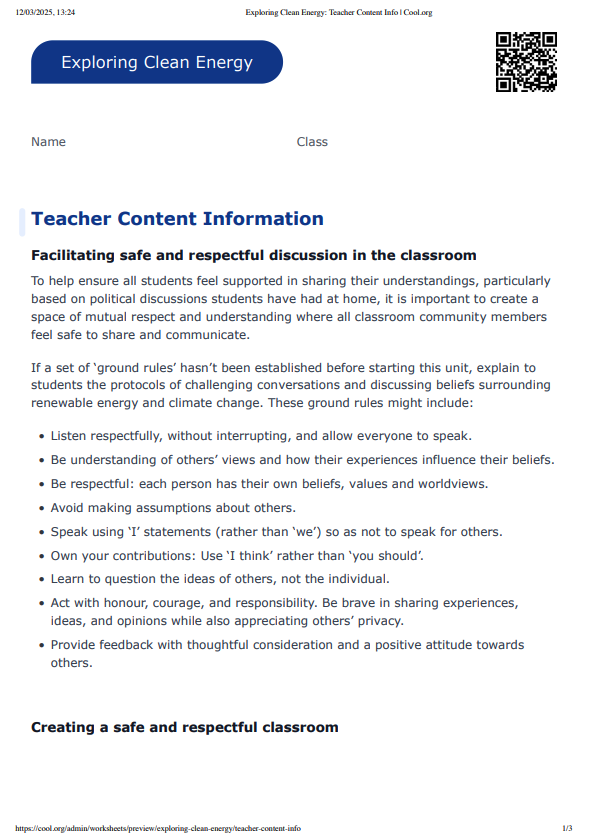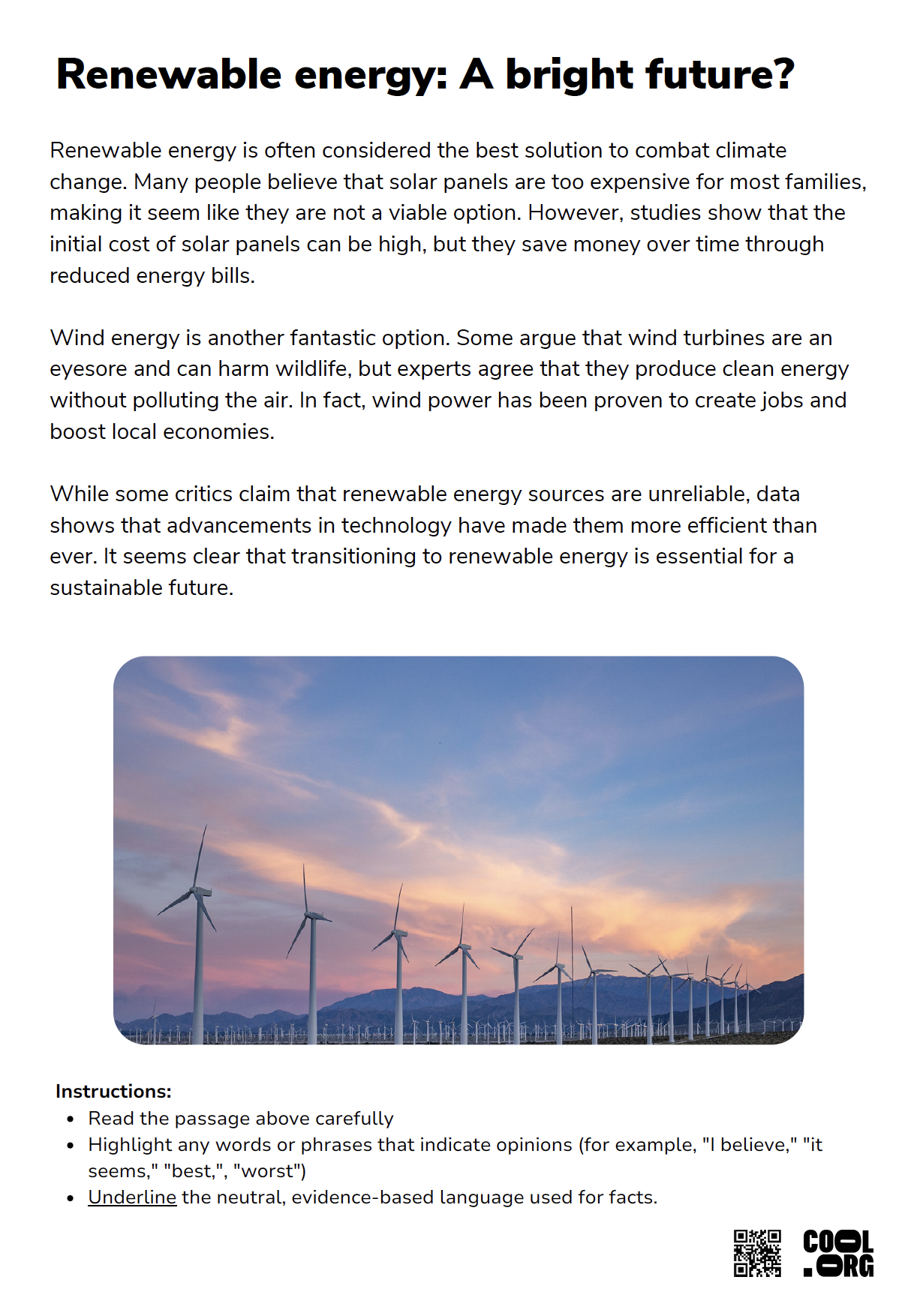Lesson summary
Students will learn to differentiate between fact and opinion by examining statements of bias surrounding clean energy. They will use questioning, research and personal experiences to examine media texts and identify the differences in language used to persuade and inform them. They will reflect on their biases and think about how to use this information to examine online information more critically.
Learning intentions
Students will:
- explore different viewpoints on clean energy.
Success criteria
Students can:
- understand the difference between fact and opinion
- add credibility to statements.
Lesson guides and printables
Curriculum links
Select your curriculum from the options below.
Lesson details
Skills
This lesson is designed to build students’ competencies in the following skills:
- critical thinking
- collaboration
- communication
- curiosity
- digital literacy
- problem-solving
- reflection
UN Sustainable Development Goals
Target 4.7: By 2030, ensure that all learners acquire the knowledge and skills needed to promote sustainable development, including, among others, through education for sustainable development and sustainable lifestyles, human rights, gender equality, promotion of a culture of peace and non-violence, global citizenship and appreciation of cultural diversity and of culture’s contribution to sustainable development.
Curriculum Mapping
Australian Curriculum (v9.0) content description:
Year 5, English
Students learn to:
- understand how to move beyond making bare assertions by taking account of differing ideas or opinions and authoritative sources (AC9E5LA02)
- use appropriate interaction skills, including paraphrasing and questioning, to clarify meaning, make connections to their own experiences, and present and justify an opinion or idea (AC9E5LY02).
Year 6, English
Students learn to:
- examine texts, including media texts that represent ideas and events, and identify how they reflect the context in which they are created (AC9E6LY01)
- use interaction skills and awareness of formality when paraphrasing, questioning, clarifying and interrogating ideas, developing and supporting arguments, and sharing and evaluating information, experiences and opinions (AC9E6LY02).
Relevant parts of Year 5 English achievement standards: Students interact with others and listen to and create spoken and/or multimodal texts, including literary texts. For particular purposes and audiences, students share, develop and expand on ideas and opinions, using supporting details from topics or texts.
Relevant parts of Year 6 English achievement standards: Students read, view and comprehend different texts created to inform, influence and/or engage audiences.
NSW Syllabus outcomes:
A student
- communicates to wide audiences with social and cultural awareness by interacting and presenting and by analysing and evaluating for understanding (EN3-OLC-01).
General capabilities: Critical and Creative Thinking, Digital Literacy, Literacy, Personal and Social Capability
Cross-curriculum priority: Sustainability
Level of teacher scaffolding: Medium - scaffolding is required when the students are guided through task instructions and reflection.
Resources Required
- Fact vs opinion activity sheet
- Opinion statement cards activity sheet
- Device capable of displaying audiovisual material
- Highlighters
- Pens
- Sticky notes
- Student devices
- Thumbs up, thumbs down Visual Explainer
Additional Info
Cool.org thanks our philanthropic funder, Boundless Earth for their generous contributions and collaboration in creating these resources.





Welcome back!
Don't have an account yet?
Log in with:
Create your free Cool.org account.
Many of our resources are free, with an option to upgrade to Cool+ for premium content.
Already have an account?
Sign up with:
By signing up you accept Cool.org's Terms and Conditions(Opens in new tab) and Privacy Policy(Opens in new tab).